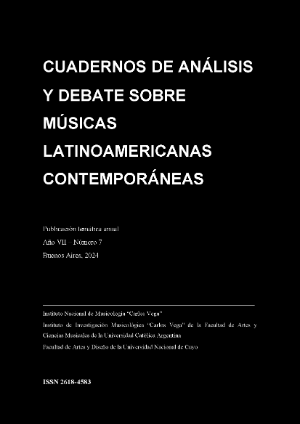Serialism, Intertextuality, Cryptology and some Lines of Flight: Jorge Horst’s herético furor (1998, revised in 2001)
DOI:
https://doi.org/10.46553/mlc.7.2024.pp30-57Keywords:
Argentine contemporary music, musical analysis, all-interval row, cryptography, Pierrot ensemble, Luigi NonoAbstract
herético furor (1998, revised in 2001), for alto flute, bass clarinet, violin, cello and piano, is one of the most studied, renowned and performed compositions by Jorge Horst (Rosario, 1963). Hence, the homage to Filippo/Giordano Bruno, connoted form the title, along with the concomitant establishment of F, Bb and G as writing axes, the different instances of repetition, the morphological ambiguities, the preeminence of diverse types of sound production, and a tandem between certain Nonian reminiscences and the presence of the all-interval row frequently associated with Il canto sospeso (1955-56) are some of the features established for herético furor. Nonetheless, given the all-interval row fulfills several purposes, while its becoming in and relationship with multiple contents implies further intricacies, we delve in the rhizome that makes up some of the serial, intertextual and cryptic traits of the composition. In other words, shed light on herético furor from its serial attributes enables lines of flight that leads us to propose the notion of implicit intertextuality and, thus, to also expand the competence of musical cryptography, mainly representations and homage, to reach the sphere of cryptology as standpoint and modus operandi.
Downloads
References
Barthes, Roland. 1994 [1967]. “La muerte del autor”. En El susurro del lenguaje. Más allá de la palabra y de la escritura, traducido por C. Fernández Medrano, pp.65-72. Barcelona: Ediciones Paidós.
Boyd, Malcom. 2001. “B-A-C-H”. En Grove Music Online, editado por Deane Root et al. https://doi.org/10.1093/gmo/9781561592630.article.01688 DOI: https://doi.org/10.1093/gmo/9781561592630.article.01688
Daverio, John. 2002. Crossing Paths. Schubert, Schumann, and Brahms. New York:Oxford University Press. https://doi.org/10.1093/acprof:oso/9780195132960.001.0001 DOI: https://doi.org/10.1093/acprof:oso/9780195132960.001.0001
Deleuze, Gilles y Félix Guattari. 2015 [1980]. Mil mesetas. Capitalismo y esquizofrenia, traducido por José Vázquez Pérez. Valencia: Pre-Textos.
Diez, Santiago, Sebastián Di Sanzo, Luciano Giambastiani y Matías Giuliani. [2002]. “Jorge Horst. Lírica de seducción del sonido. La repetición como elemento de valor discursivo”. Monografía de cátedra, Universidad Católica Argentina. Archivo personal de Jorge Horst.
Fessel, Pablo. 2017. “La propia interpretación en los escritos de Gerardo Gandini”. El oído pensante 5, 2, pp. 57-75.
Foucault, Michel. 2010 [1969]. ¿Qué es un autor?, traducido por Silvio Mattoni. Córdoba y Buenos Aires: Ediciones literales y El cuenco de plata.
Gariglio, Federico. 2010. Punto contra punto. Point counter point. Buenos Aires: Dunken.
Gaviola, Natalia. 2002. “Aspekte der Neuen Musik in Argentinien nach 1950”. Tesina, Staatliche Hochschule für Musik, Freiburg im Breisgau. Archivo personal de Jorge Horst.
Grant, Morag J. 2001 [1987]. Serial music, serial aesthetics. Compositional theory in post-war Europe. Cambridge: Cambridge University press.
Griffiths, Paul. 2001. “Serialism”. En Grove Music Online, editado por Deane Root et al. https://doi.org/10.1093/gmo/9781561592630.article.25459. DOI: https://doi.org/10.1093/gmo/9781561592630.article.25459
Guattari, Félix. 2013 [2011]. Líneas de Fuga. Por otro mundo de posibles, traducido por Pablo Ariel Iles. Ciudad Autónoma de Buenos Aires: Cactus.
Horst, Jorge. 2007. “Acracia y composición musical”. En Nuevas poéticas en la música contemporánea argentina. Escritos de compositores, editado por Pablo Fessel, pp. 41-50. Buenos Aires: Biblioteca Nacional. Traducido al alemán como Horst, Jorge. 2013. “Übertreten der eigenen Grenzen. Anarchie und Komposition”. MusikTexte 136, pp. 11-14.
Iddon, Martin. 2013. New Music at Darmstadt. Nono, Stockhausen, Cage, and Boulez. New York: Cambridge University Press. https://doi.org/10.1017/CBO9781139519571 DOI: https://doi.org/10.1017/CBO9781139519571
Iddon, Martin.. (Ed.) 2023. The Cambridge Companion to Serialism. New York: Cambridge University Press. https://doi.org/10.1017/9781108592116 DOI: https://doi.org/10.1017/9781108592116
Jaureguiberry, Pablo. 2021. “Entre ideología, política y criptografía: una aproximación a la presencia del Che en la música de Jorge Horst”. En XIV Jornadas Estudios e Investigaciones “Interdisciplinariedad y abordajes teórico-metodológicos en la historia de las artes”, compilado por Ricardo González y Alejandra Niño Amieva. Ciudad Autónoma de Buenos Aires: Instituto de Teoría e Historia del Arte “Julio E. Payró”.
Jaureguiberry, Pablo. 2022. “Jorge Horst y lo ideológico-político: un acercamiento a su recepción de la poética de Luigi Nono, con foco en la serie paninterválica”. Revista Argentina de Musicología 23, 1, pp. 153-179.
Jaureguiberry, Pablo. 2023. “barro sublevado (2003) de Jorge Horst: ¿un tango culto recursivamente transatlántico?”. Revista Neuma 16, 2, pp. 112-129. https://doi.org/10.4067/S0719-53892023000200112 DOI: https://doi.org/10.4067/S0719-53892023000200112
Kostka, Violetta, Paulo F. de Castro y William A. Everett. (Eds.) 2021. Intertextuality in Music. Dialogic Composition. Oxon y New York: Routledge. DOI: https://doi.org/10.4324/9781003092834
Miranda, Ricardo y Aurelio Tello. 2011. La música en Latinoamérica. México D. F.: Secretaría de Relaciones Internacionales. Dirección General del Acervo Histórico Diplomático.
Molina, Jorge Edgard. 2005. “música e ideología. ‘herético furor’ de Jorge Horst”. En Estética del fin de siglo 2: summarium 4, pp. 190-244. Santa Fe: el autor. En pp. 216-243 hay una reproducción de la partitura digital, con dos páginas iniciales de paratexto.
Nono, Luigi. 2018. Nostalgia for the Future. Luigi Nono’s Selected Writings and Interviews, editado por Angela Ida De Benedictis y Veniero Rizzardi, traducido por John O’Donnell. California: University of California Press. https://doi.org/10.1525/california/9780520291195.001.0001 DOI: https://doi.org/10.1525/california/9780520291195.001.0001
Rosenheim, Shawn. 2019 [1997]. The Cryptographic Imagination. Secret Writing from Edgar Poe to the Internet. Baltimore: Johns Hopkins University Press.
Sams, Eric. 2001. “Cryptography, musical”. En Grove Music Online, editado por Deane Root et al. https://doi.org/10.1093/gmo/9781561592630.article.06915 DOI: https://doi.org/10.1093/gmo/9781561592630.article.06915
Downloads
Published
How to Cite
Issue
Section
License
Copyright (c) 2024 Pablo Jaureguiberry

This work is licensed under a Creative Commons Attribution-NonCommercial-ShareAlike 4.0 International License.











